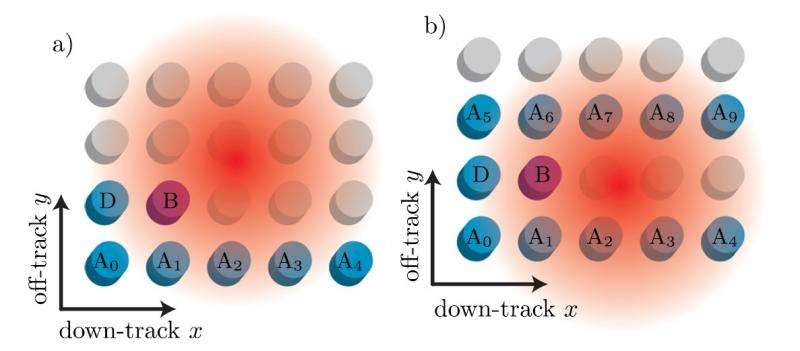March 22, 2016 feature
Storage density beyond 10 Tb/in2 possible for heat-assisted magnetic recording

(Phys.org)—Global demand for data storage is constantly increasing, driven by new technologies such as Big Data and the Internet of Things, as well as personal and enterprise storage. The hard disk drives that currently store the majority of the world's data have storage densities of just under 1 Terabit per square inch (Tb/in2). One of the promising technologies being researched for increasing the storage density is heat-assisted magnetic recording (HAMR), which uses lasers to heat individual magnetic grains that are just a few nanometers long. The method requires controlling heat and magnetism on a tiny scale, which has made developing HAMR very challenging.
In a new paper published in Applied Physics Letters, a team of physicists from TU Wien in Vienna, Austria, has developed simulations that realistically model the HAMR write process. Using the simulations, the researchers could independently control a variety of parameters that affect the storage density, and identify the circumstances under which HAMR can achieve its optimal storage density, which they found could be more than 13 Tb/in2.
"The resulting storage density of 13.23 Tb/in² would definitely be the highest density of any commercially available memory to date," coauthor Christoph Vogler at TU Wien told Phys.org. "With such a density, a conventional hard disk drive could have more than 10 times the capacity of today's devices, at the same size. The high density, along with the long-term stability of the stored data, would have a significant impact on desktop and enterprise drives."
In general, attempts to increase storage density in conventional magnetic memory are limited by the so-called "magnetic recording trilemma," which refers to the conflicting requirements of readability, writability, and stability. Basically, as the grain size decreases, switching the grains' magnetic properties becomes so easy that thermal fluctuations cause unwanted switching, which greatly decreases the long-term stability of the stored information at room temperature. To increase the stability, the grains need to have a very high coercivity, which means that they must be able to maintain their magnetic state in the presence of external magnetic fields. However, a high coercivity also makes the grains more difficult to write because it requires producing a powerful magnetic field in a very small space. As the scale decreases, the magnetic field simply cannot be made strong and precise enough, and writing data becomes impossible.
HAMR may offer a solution to the magnetic recording trilemma by taking advantage of the fact that coercivity is temperature-dependent (hence the name "heat-assisted magnetic recording"). The method uses a laser to increase the temperature of an individual grain to above the Curie temperature, a critical point that temporarily decreases the grain's coercivity. Then a relatively small magnetic field can be used to write data on this grain by aligning its magnetization along the applied field, while surrounding grains are not affected because they have not been heated by the laser and so maintain their high coercivity.
The challenge to making HAMR work depends on a variety of factors, such as the temperature and position of the laser, as well as the spacings and patterns of the grains. The new simulations presented here have tested various combinations of these parameters and allowed the researchers to determine the optimal combinations for the highest storage density.
"We have developed a realistic simulation model of the whole complex HAMR process, which allows to accurately calculate the write dynamics of a device in a reasonable amount of simulation time," Vogler said. "Consequently, we could systematically optimize the major parameters of the write process in order to show that a HAMR device with 10 Tb/in² and more is feasible and how such densities can be reached."
In the future, this information will serve as an important guideline for designing HAMR memories with both high density and high stability.
"In the future, we plan to investigate recording grains with a more complex structure, consisting of several layers with different magnetic properties," Vogler said. "With these grains we hope to increase the write speed of the hard disk drive by maintaining the areal density. In general, manufacturing the proposed grain patterns is not yet feasible but is expected to be within the next years."
More information: Christoph Vogler, et al. "Heat-assisted magnetic recording of bit-patterned media beyond 10 Tb/in2." Applied Physics Letters. DOI: 10.1063/1.4943629
Journal information: Applied Physics Letters
© 2016 Phys.org





















